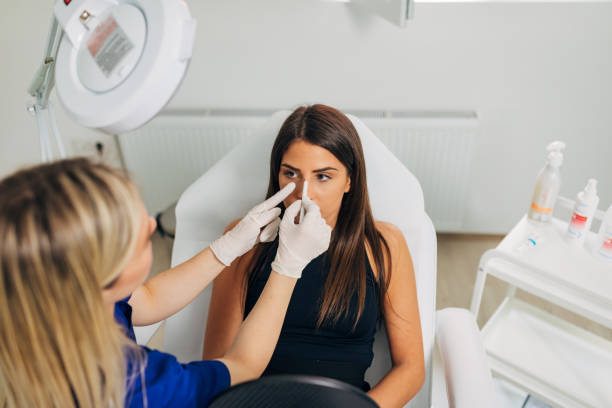
Rhinoplasty, commonly known as a nose job, is a popular cosmetic procedure that reshapes the nose to improve both appearance and function. Whether you’re considering this surgery for aesthetic reasons or to correct breathing issues, understanding the recovery process is essential for achieving the best results. In this article, we will guide you through the key stages of healing after rhinoplasty, offer helpful tips to speed up recovery, and explain what to expect during the entire timeline.
The journey to a new nose doesn’t end in the operating room. Rhinoplasty in Riyadh requires careful post-surgery care and patience to ensure the final results look natural and last a lifetime. Recovery can vary depending on the complexity of the procedure and individual healing rates, but with proper care, most patients find the process manageable and rewarding.
What Happens Immediately After Rhinoplasty?
Right after the surgery, it is common to experience swelling, bruising, and mild discomfort around the nose and eyes. This initial period is crucial for setting the foundation for healing.
Managing Swelling and Discomfort
Applying cold compresses gently around the eyes can help reduce swelling and ease discomfort. Patients are advised to keep their head elevated, even while sleeping, to minimize fluid buildup in the face. Avoiding strenuous activity during this phase reduces the risk of increased blood flow that might worsen swelling.
Protecting Your Nose
A nasal splint or cast is usually placed on the nose to support its new shape and protect it from accidental bumps. It’s important not to disturb this splint until the surgeon removes it, typically about one week after surgery.
The First Week of Recovery
The first week after rhinoplasty is when most visible changes occur. Swelling and bruising tend to peak within the first two to three days, then gradually improve.
What to Expect During the First Week
Bruising may extend from the nose to the cheeks and under the eyes, often resembling black-and-blue marks. This is normal and will fade with time. Patients may also experience nasal congestion due to internal swelling, which can make breathing through the nose temporarily difficult.
Important Tips for the First Week
During this time, avoid blowing your nose to prevent disrupting the healing tissues. Gentle cleaning of the nasal area as advised by the healthcare provider keeps the area hygienic and helps prevent infection. Patients should avoid wearing glasses that rest on the nose until it fully heals, as this pressure could alter the surgical outcome.
Weeks Two to Four: Swelling Reduction and Healing Progress
After the initial intense swelling decreases, many patients begin to see improvements in their appearance and feel more comfortable with daily activities.
Resuming Normal Activities
Most people can return to work or school within two weeks, but heavy exercise and activities that risk facial injury should still be avoided. Continued elevation of the head during sleep can aid in reducing residual swelling.
Subtle Changes and Patience
Even as swelling goes down, the nose will continue to refine in shape and contour over several weeks and months. It’s important to be patient during this period as minor irregularities settle and the final look emerges gradually.
Long-Term Healing: Months Three to Twelve
Full recovery from rhinoplasty is a gradual process that can extend over several months. The subtle swelling deep within the nasal tissues takes the longest to resolve.
Final Appearance and Touch-Ups
By the six-month mark, most swelling is gone and the nose looks close to its final shape. However, minor changes and softening of the nasal tip and bridge may continue up to a year after surgery.
Maintaining Results and Care
Protecting your nose from injury and sun exposure remains important during the first year. Sunscreen helps prevent discoloration of the sensitive skin on the nose, which can occur as the tissues heal.
Common Recovery Challenges and How to Overcome Them
Dealing with Emotional Ups and Downs
It’s normal to feel impatient or anxious during the recovery period. The appearance immediately after surgery might not match your expectations due to swelling, but keeping realistic goals and communicating with your surgeon can help manage concerns.
Avoiding Complications
Strictly following post-operative instructions reduces the risk of infection, bleeding, or unfavorable scarring. If any unusual symptoms like excessive pain, fever, or discharge occur, medical attention should be sought promptly.
Essential Lifestyle Tips for a Smooth Recovery
-
Maintain a balanced diet rich in vitamins and proteins to promote healing
-
Stay hydrated to keep tissues healthy
-
Avoid smoking and alcohol, which can delay recovery
-
Follow all care instructions provided by your healthcare professional
Frequently Asked Questions About Rhinoplasty in Riyadh
What activities should I avoid after rhinoplasty?
Avoid heavy exercise, contact sports, and any activity that might risk bumping your nose for at least six weeks to prevent damage during healing.
When can I expect to see the final results?
While initial swelling reduces in weeks, the nose continues refining up to a year. Most patients see near-final results by six months.
Is nasal congestion normal after surgery?
Yes, swelling inside the nose can cause congestion that usually improves within the first two weeks.
Can I wear glasses after rhinoplasty?
It’s best to avoid wearing glasses that rest on your nose for at least four to six weeks, or use special supports as advised by your surgeon.